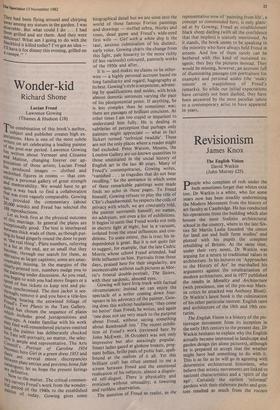Books
The camera's eye
Paul Overy
The Artist as Photographer Marina Vaizey .(Sidgwick & Jackson £12.95) The Artists of my Life Brassai (Thames & Hudson £20)
Photography was not 'invented' in the 1820s or 1830s. Cameras had been in use for many centuries — the camera obscura was employed at least since the Renaissance by artists and topographers as a drawing aid. What was discovered in the early 19th century were ways of fixing the image by chemical means rather than by laborious tracing.
There were those who feared that the new technique would destroy the artist. The well known exclamation of the French history painter, Paul Delaroche, is used by Marina Vaizey as the title for the first chapter of her book: `From today painting is dead.' It was a false alarm. Although, no doubt, many local and topographic artists went to the wall or, more likely, quickly adapted and became jobbing photographers, artists were quick to use photography as an aid. And photographers — because so many of them had been brought up in fine art traditions or practice — used the art of the past as the basis for their work. Only gradually did photography establish a separate identity, largely because many who subsequently took it up came from literary or academic backgrounds rather than that of artist. Photography is in many ways as close to literature as it is to art. But it is the relation- ship between art and photography with which Marina Vaizey's book is concerned.
Two earlier books have covered the com- plicated interaction between painting and photography, Aaron 'Scharf's Art and Photography and Van Deren Coke's The Painter and the Photograph. Although in- evitably she retraces some of the ground already covered by these earlier authors, Marina Vaizey has tried to confine her study to an examination of the photographs that artists have taken themselves. But in practice she has extended this definition to include photographs taken by others to their specification and even to those The Spectator 13 November 1982 photographs, not specially commissioned' which painters have employed in the': work. She has not been helped by publishers who have severely restricted the number of plates which are often small s,.11d ,, badly reproduced. Thus many artists 0" are discussed in detail, some of whom are, not particularly well known, do not JO" their work illustrated at all. This ,j unhelpful in a book which seems intended for the non-specialist reader. Perhaps the most interesting chapter is `The Artist as Archivist' about sculptuP who have taken photographs of their work like Brancusi, or carefully control!l the way in which others have photograPiley them, like Rodin. The final chapters disceessd recent artists who have employ 5 photography in various different ways: e section is particularly hampered by old paucity of visual examples. It surelY W0 have made better sense to have been ulech more selective, concentrating on a limited
, number of artists who had taken their ovo: photographs and illustrate their work more fully with better quality reproductions. 4
Brassai is one of those photograPheci who were trained as artists but later torild to the camera. His early background inof gives him a rapport with artists and sohl,e,eit his best pictures are of artists and t"er works. His new collection gathers togetuhi many of the photographs commissioneu te the 1930s for the art review Le Minot to and later for Harper's Bazaar. Probably se, finest are those of Matisse, especially til4 quence of him drawing from a nude illwd in 1939. He sits with pencil and drawitIA,P1 in a white coat looking like an °Z gynaecologist as he stares thoughtfetnsi the model whom he has placed in the extraordinary and expressive poses. Lie) The text of The Artists of my Life Which -
consists of Brassai's recollections of the
lh tists and remembered conversations with them, is sharp and observant. He is „Pe is ticularly good with sculptors. SculPtu' 1,v clearly a greater challenge to photol; than painting — Brassai made , tore brilliant photographs of Picasso's scuiri h, — and, having been a sculptor hirhse appears to have an affinity with thou. are sections on Maillol and Laurens As especially rewarding. Both his photograp and recollections of Maillol, looking talking like an old French Catalan Peasan bring to life an artist whose work 11310 substantial re-assessment and rella tion. As Maillol shows Brassai round s of studio he moves among his scuiPtu'lleir naked women: `His eye travels over j,00 rounded bodies, hands caress a bilairoger break, the column of a thigh, and lease
over the curve of a knee or calf, the ar
of a hip still covered with a damP love
he taps a swelling pair of buttocks. ttacos,
to caress buttocks, lovely full „one eThey'rever creattehde.,most beautiful shape cat 1°i
On another occasion when his - .flo
n Mal just killed a blackbird in the garden' .0 one says: ` "The other day he killed tuidh
afternoon ... two lovely little ru'"
They had been flying around and chirping away among my statues in the garden. I was Miserable. But what could I do ... I had them grilled and ate them. And they were delicious! What am I going to do with the blackbird it killed today? I've got an idea — 111have it for dinner this evening, grilled on a eanak.,,















































 Previous page
Previous page